RHD is a serious and fatal disease in rabbits. It is also known as VHD (Viral Haemorrhagic Disease) and RCV (Rabbit Calicivirus). Until recently, the only strain of the virus present in the UK was RHD-1; however, a new (and potentially more dangerous) form of the disease has recently become established here, called (imaginatively) RHD-2. 
Why do I need to protect my rabbit?
Because the disease has a mortality rate anywhere between 50% and 100% – in most outbreaks, we see between 90% and 100% of unprotected rabbits dying. It is a highly contagious disease, and one infected rabbit will rapidly spread it to others in the area. We do not know why a (very) few infected rabbits survive, but it’s probably due to a slight difference in the way their immune system responds to this particular infection.
How is it spread?
The virus is passed from rabbit to rabbit by direct transmission and is present in all the bodily fluids (so maybe coughed, urinated, dribbled or defecated out!). However, it is very stable in the environment (it is estimated to last about 100 days at room temperature, and longer if it’s cold – plus, it is resistant to freezing). As a result, the main route of transmission between colonies of rabbits is by passive transfer – the virus particles stick to the feet of a bird, rodent or human, who then carries them to new and vulnerable bunnies. In the case of pets, not even house rabbits are safe, because the virus particles may be carried in on your shoes, clothes or even your skin. Short of full biosecurity precautions (foot dips, disinfectant washes and showers, complete changes of clothing) every time you visit them, there’s always going to be a chance you’re carrying this deadly disease into the house.
In a rabbit who has been fantastically lucky, caught the disease and recovered, they will shed the virus for at least six weeks (and possibly longer) so must be kept in quarantine for a prolonged time to protect other bunnies.
What are the symptoms?
To some extent, the symptoms depend on the strain of the virus, although the two are very closely related and therefore cause similar clinical signs. The most common symptom with RHD-1 is sudden death, often (but not always) with bleeding from the nose and mouth immediately afterwards. Sometimes, rabbits may last a little longer, perhaps even a couple of days; if so, they will be very feverish, depressed and lethargic,
be prone to bleeding from nose, mouth and anus, and often will develop bruising under the skin or a rash (like in septicaemia). They will usually die within 48 hours of first developing symptoms.
RHD-2 is often slower (although sudden death does occasionally occur), with rabbits living for up to nine days before succumbing – the overall mortality rate, however, seems to be roughly the same. However, the problem with RHD-2 is that, because the rabbits live longer, they spread more of the virus around.
What is the treatment?
There is no treatment for RHD-1 or -2. Because the outcome is so unlikely to be good, and the severe suffering this disease causes, we may have to recommend that affected rabbits are put to sleep if they develop the disease. This is important on welfare grounds (the rabbit is very unlikely to recover, and will suffer unnecessarily), and also to minimise the risk to other rabbits.
Occasionally, a rabbit will have only very mild symptoms – these are likely to be those rabbits whose immune systems have been partially successful in combating the infection. In these cases, supportive care with pain relief, fluid therapy and antibiotics (against secondary infections) may be helpful.
Can it be prevented?
Yes, fortunately! There has been a vaccine against RHD-1 and Myxomatosis available for many years, which is highly effective in preventing the disease. Unfortunately, it is not very effective against RHD-2, hence the recent outbreaks, but a new European vaccine against RHD-2 has just recently become available.
Other measures may also reduce the risk of infection, such as double-walling outdoor hutches to prevent any contact with wild rabbits, birds or rodents; or moving rabbits indoors. However, these should be seen as adjuncts to vaccination, not a replacement for it.
If you want to talk about RHD protection, call us and talk to one of our vets.
